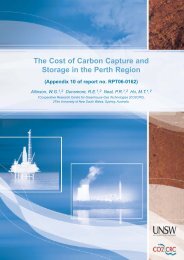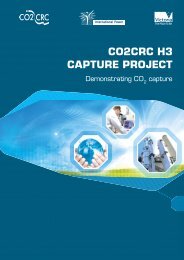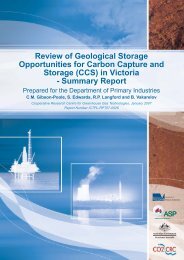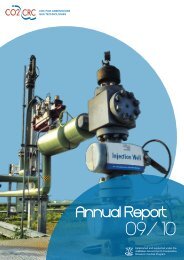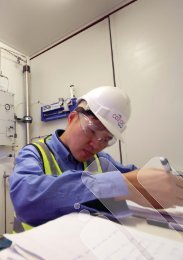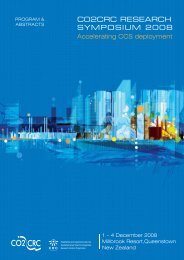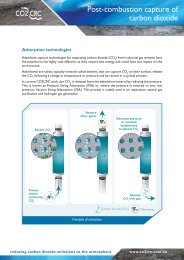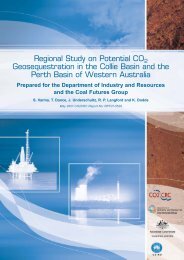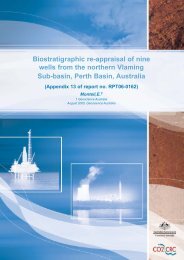Read the full report (PDF27.8 MB) - CO2CRC
Read the full report (PDF27.8 MB) - CO2CRC
Read the full report (PDF27.8 MB) - CO2CRC
You also want an ePaper? Increase the reach of your titles
YUMPU automatically turns print PDFs into web optimized ePapers that Google loves.
A four year demonstration site for carbon capture and storage (CCS) technology, located<br />
approximately 200 km east of <strong>the</strong> Denison Trough, with an annual CO 2 output of 75 000 tonnes has<br />
previously been proposed (Spero, 2005). There are 11 fields within <strong>the</strong> Denison Trough which have<br />
an equal or greater storage potential than <strong>the</strong> projected CO 2 volume produced. Four of <strong>the</strong>se fields<br />
could have 12 years of storage potential, with two of those having more than forty years of storage<br />
potential for this scale of project. However, it should be noted that <strong>the</strong> fields are all currently in<br />
production, and as such, are most likely unavailable for use as CO 2 storage sites at <strong>the</strong> present time.<br />
A second proposal indicated a possible 25 year project (Sayers et al., 2006) with a CO 2 output of<br />
approximately 1.2 million tonnes per annum (Mt/y) for a total storage volume of 30 Mt. The entire<br />
Denison Trough CO 2 equivalent volume produced from fields is approximately 14.9 Mt,<br />
representing less than thirteen years storage.<br />
The Denison Trough <strong>the</strong>refore appears to offer many years of potential storage in depleted fields for<br />
a small scale demonstration CCS projects. However, higher risk storage and injection scenarios in<br />
low permeability rocks could be investigated to accommodate <strong>the</strong> storage capacity required for<br />
larger CCS projects (Sayers et al, 2006).<br />
5.3. East Bowen Basin Study Area – Burunga Anticline / Dulucca<br />
Area<br />
This project assessed <strong>the</strong> CO 2 storage potential of sites close to stationary CO 2 sources in <strong>the</strong> east<br />
Bowen Basin, Queensland (Figure 2.1b; Appendix 10.3). The Flat Top Formation within <strong>the</strong><br />
Burunga Anticline and <strong>the</strong> Showgrounds Sandstone within <strong>the</strong> Trelinga structure (Dulucca area),<br />
were <strong>the</strong> primary focus of <strong>the</strong> investigation.<br />
The project involved:<br />
• a sedimentary basin analysis, involving <strong>the</strong> analysis and interpretation of 12 composite well<br />
logs and 14 well completion <strong>report</strong>s;<br />
• a paleogeographic reconstruction and <strong>the</strong> assessment of <strong>the</strong> suitability of reservoir sand and<br />
overlying seal units;<br />
• a petrophysical evaluation, and<br />
• a seismic interpretation of 40 sections to assess structural form and trends.<br />
The <strong>report</strong> concluded that both <strong>the</strong> Showgrounds Sandstone and <strong>the</strong> Flat Top Formation possess<br />
negligible storage potential in this region of <strong>the</strong> Bowen Basin. The Flat Top Formation is a highly<br />
variable lithological unit with low net-to-gross sandstone and poor porosity–permeability<br />
correlation within individual facies. Hence, <strong>the</strong> predictability of reservoir quality in this unit is low.<br />
The Showgrounds Sandstone, also has poor reservoir quality, is truncated by <strong>the</strong> (basal) Surat Basin<br />
unconformity and overlain by <strong>the</strong> fresh water bearing sandstone units of <strong>the</strong> Great Artesian Basin.<br />
A sealing unit is absent so that CO 2 injected into <strong>the</strong> Showgrounds Sandstone could potentially<br />
migrate directly into <strong>the</strong> overlying fresh water aquifer. Both <strong>the</strong> Flat Top Formation and<br />
Showgrounds Sandstone are <strong>the</strong>refore considered to have significant reservoir and seal risk.<br />
The only alternative reservoir in <strong>the</strong> area is <strong>the</strong> Precipice Sandstone, a fresh water aquifer within <strong>the</strong><br />
eastern Surat Basin. Whilst <strong>the</strong> Precipice Sandstone possesses significant storage potential, injecting<br />
CO 2 into <strong>the</strong> Precipice Sandstone would, as already stated, sterilise <strong>the</strong> fresh water resource from<br />
future use so that using this aquifer for geological storage is not considered a viable option at<br />
present.<br />
32



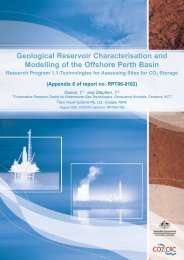
![Post-combustion solvent absorption [PDF 438KB] - CO2CRC](https://img.yumpu.com/48575763/1/184x260/post-combustion-solvent-absorption-pdf-438kb-co2crc.jpg?quality=85)

